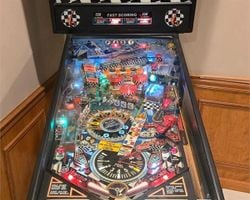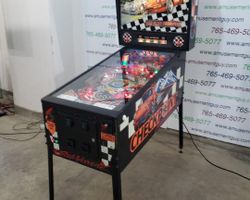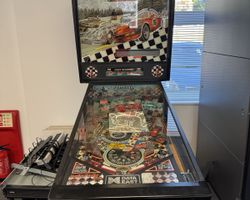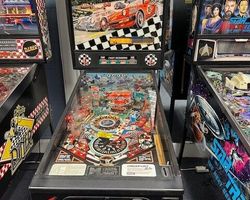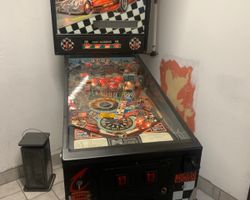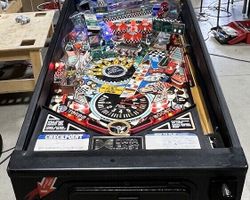Checkpoint
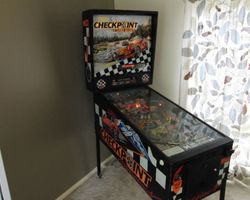
Average Prices: USD $400 to $1,600
Produced: Febuary, 1991
Production Run: 3,500 units
Machine Type: Solid State Electronic
MPU: DataEast/Sega Version 3
Players: 4
Design by: Ed Cebula, Joe Kaminkow
Art by: Paul Faris
Dots/Animation by: Kristina Donofrio, Todd Farris
Music by: Brian Schmidt
Sound by: Brian Schmidt
Software by: Rehman Merchant
February of 1991 marked a notable moment in pinball history with the release of "Checkpoint" by Data East USA, Inc. This pinball machine, produced in a run of 3,500 units until May of that year, carved out a unique position for itself, particularly through its innovative display technology. Its creation was an ambitious endeavor that saw Data East push technological boundaries, culminating in a game centered around the high-octane world of auto racing, featuring iconic Porsche imagery and the thrill of the open road.
The genesis of "Checkpoint" involved a collaborative effort from a dedicated team. Joe Kaminkow and Ed Cebula spearheaded the design, crafting a playfield layout that surprisingly drew inspiration from Data East's 1989 release, "Robocop." Despite "Robocop" not achieving significant commercial success, its core playfield structure was deemed robust, leading to its adaptation and refinement for "Checkpoint." The machine's visual identity was brought to life by artist Paul Faris, whose vibrant palette and dynamic depiction of race cars and scenic European road rally backdrops defined the cabinet and playfield art. The auditory experience was masterfully handled by Brian Schmidt, who composed the music and designed the sound effects, while Rehman Merchant developed the intricate software. Kristina Donofrio and Todd Farris were responsible for the machine's animations, and Fred Young lent his voice talents for characterizations.
A pivotal decision during "Checkpoint's" development was the integration of a Dot Matrix Display (DMD). Initially conceived with a traditional alphanumeric display, testing revealed a need for a more engaging visual component. Data East pivoted, retrofitting the machine with a DMD, making "Checkpoint" the first pinball machine to feature this groundbreaking technology. This was a calculated risk; the company's president and CEO, Joe Keenan, had initially expressed reservations about rushing DMD development for their previous title, "The Simpsons," fearing potential production setbacks. "Checkpoint" ultimately served as the pioneer, albeit with a "half-height" DMD, a precursor to the larger, standardized displays that would soon dominate the industry. Beyond the DMD, "Checkpoint" introduced another novelty: it was the first pinball machine to feature a patented combination automatic ball shooter and spring plunger, offering players a dual approach to launching the ball into play. Early test models of "Checkpoint" featured white cabinets and alphanumeric backglasses, but these were swiftly refined for production, with the white cabinets replaced due to their tendency to show dirt and the alphanumeric display yielding to the revolutionary DMD.
Signature Features and Design
"Checkpoint" is replete with distinct features that set it apart and enhance its thematic immersion. The most prominent, of course, is its Dot Matrix Display. While smaller than the full-sized DMDs that would follow, this display delivered surprisingly fluid and thematic animations, providing visual feedback and enhancing storytelling in ways previously impossible. The machine’s commitment to its racing theme is evident from the moment a player steps up: instead of a traditional start button, "Checkpoint" incorporated an ignition key, a tangible and engaging gimmick that immediately pulls players into the driver's seat.
Further adding to the sensory experience, a shaker motor is integrated into the cabinet, dynamically activating to simulate engine revs and the vibrations of a high-speed vehicle. This physical feedback amplifies moments of intensity, such as during critical shots or when reaching higher RPMs. On the playfield, a miniature Porsche Carrera car toy is strategically placed above the Nitro target, visually reinforcing the machine's dedication to its automotive theme. The backglass design is also noteworthy, featuring a mirrored finish that adds a touch of elegance and visual depth. Within the backbox, a spinning Carrera wheel forms the "o" in the "Checkpoint" logo, a subtle yet captivating animated detail that reinforces the machine's identity. Before gameplay even begins, "Checkpoint" offers players a choice of six different music styles, allowing for a personalized soundtrack to their racing experience, a feature rarely seen in pinball machines of its era. This selection, along with the MPH speedometer on the speed ramp that dynamically measures and displays the ball's velocity, further enriches the feeling of being in a high-performance vehicle.
Playfield and Mechanics
The playfield layout of "Checkpoint," though derived from "Robocop," was refined to optimize for speed and flow, creating an energetic and direct gameplay experience. Paul Faris's artwork provides a vivid backdrop, depicting vibrant racecourses and German locales, complementing the fast-paced action with a colorful and detailed aesthetic. The playfield's primary focus revolves around a singular, central speed ramp, a dominant feature that demands precision and becomes central to achieving high scores. This ramp is not merely a shot; it's a dynamic element that registers the ball's speed in miles per hour, translating directly into points and contributing to the game's progressive RPM system. Successfully hitting the ramp repeatedly also lights country flags, with a challenging objective of lighting all consecutively for a substantial 10 Million point award.
Below the main ramp, a set of seven CARRERA drop targets, divided into a four-bank and a three-bank, present a crucial objective. Completing these targets advances the jackpot value, increases RPM, and can activate the "Blue Light Special" mode. To the right, under the distinctive Porsche toy, lies the Nitro target, a key shot for significant points, particularly when the "Hot Nitro Round" is active. On the left side of the playfield, the "Spin-N-Win" spinner offers a satisfying, high-scoring opportunity for players who can keep the ball spinning through it. The top of the playfield features three L-A-P lanes, which are instrumental in advancing the RPM meter and progressing towards "FAST Mode." Three pop bumpers add chaos and additional point-scoring opportunities, while the "Flat Tire" target offers a chance to boost their value. The rightmost lane, designated "Checkpoint," feeds an upkicker and is vital for initiating multiball and doubling jackpot values. Strategic use of the powerful "Ultimate" Data East flippers is essential for navigating this layout, directing the ball through the critical shots, and managing its rapid flow.
Gameplay Dynamics
"Checkpoint's" gameplay is built around a relentless pursuit of speed and a progressive scoring system driven by RPMs. The game begins with an engaging choice of six music tracks, setting the stage for the session. A unique skill shot challenges players to hit the ramp within five seconds of the automatic plunge, awarding a lucrative bonus based on the current ball number. The core progression mechanic revolves around increasing "RPM" (Revolutions Per Minute). This value is accumulated by hitting various targets and lanes, including the Pit Stop saucer, the lit spinner, the L-A-P lanes, the CARRERA drop targets, and even by achieving high speeds on the main ramp. Reaching specific RPM thresholds is paramount for unlocking the machine's coveted multiball modes.
"Checkpoint" features a three-ball multiball, activated by reaching particular RPM levels (6000, 7000, or 8000) and then hitting either the Checkpoint lane or Pit Stop saucer. The ultimate "Red Line" multiball is initiated at 8000 RPM. During multiball, the primary objective is to light and collect the jackpot. This requires hitting the "Checkered Flag" drop target, which then illuminates the main ramp for a limited time to collect the jackpot, with values escalating from 2 Million to 4 Million points before resetting. A strategic maneuver allows players to double their next jackpot by hitting the Checkpoint lane when the jackpot is not currently lit and all balls are in play. Losing a ball during a two-ball multiball often provides an opportunity to re-light the Checkpoint or Pit Stop to return to three balls.
Beyond multiball, "Checkpoint" offers several timed modes and challenges. "FAST Mode" is initiated by completing the L-A-P lanes and shooting the Checkpoint lane; for ten seconds, every switch hit scores a substantial 55,000 points, encouraging a flurry of rapid shots. The "BLUE LIGHT SPECIAL" appears randomly after hitting a drop target, giving players a brief window to clear remaining drop targets for valuable awards like extra balls, 1 Million points, or even the "Red Line" multiball. The main ramp also lights for single "1 Million Ramp" and "10 Million Ramp" shots, providing high-value targets for skilled players. These dynamic modes, combined with the continuous RPM progression and the strategic depth of multiball, ensure a constant push for higher scores.
Reception and Legacy
"Checkpoint" elicited a range of responses within the pinball community, with its historical significance as the first machine to feature a Dot Matrix Display frequently cited as a primary strength. This pioneering technological leap was undoubtedly its most defining characteristic, demonstrating Data East's foresight and setting a new standard for future pinball displays. Many enthusiasts appreciated the machine's robust thematic execution, with the car racing concept, especially the Porsche elements, receiving praise for its consistency and visual appeal. Paul Faris's artwork on the cabinet and backglass was often described as vibrant and striking, contributing significantly to the machine's overall allure.
Beyond the aesthetics, "Checkpoint" garnered positive feedback for its array of unique features. The ignition key start, the innovative MPH display on the ramp, the integrated shaker motor that simulated engine vibrations, and the option to select different music tracks were all seen as clever and engaging additions that deepened the thematic immersion. Players often noted the game's fast-paced and fluid gameplay, describing it as energetic and accessible, making it a suitable entry point for those new to pinball. For its era and price point, it was often considered a good value proposition.
However, "Checkpoint" was not without its criticisms. The most common sentiment, particularly among seasoned players, was its perceived repetitiveness and lack of intricate depth. The game was sometimes characterized as a "one-trick pony," with a heavy emphasis on repeatedly shooting the main ramp, leading some to feel the rule set became stale over time. Shot variety, beyond the dominant ramp, was occasionally deemed limited. While the music selection was appreciated, some found the sound effects and callouts could become annoying or monotonous with extended play. The "half-height" DMD, though revolutionary, was also seen by some as a limitation, wishing for more extensive use of the screen real estate. Minor complaints included the placement of certain playfield elements and occasional ball control issues. Comparisons to more complex Williams titles of the era, such as "High Speed" or "The Getaway," sometimes positioned "Checkpoint" as a simpler experience.
Despite these mixed views on its gameplay depth, "Checkpoint's" legacy is undeniably significant due to its groundbreaking use of the DMD. It proved the viability of a richer, more animated display for pinball, irrevocably changing how game information and narrative elements could be conveyed. It also showcased Data East's willingness to innovate with integrated physical features, from the key start to the shaker motor. While it may not be remembered for the most complex rule set, "Checkpoint" remains a crucial artifact in pinball history, marking a pivotal transition point and demonstrating the potential for technological advancement within the medium.
Sponsored Links
 Ebay Listings
Ebay Listings
 Auction Results
Auction Results
| Cost | Location | Date |
|---|---|---|
| USD $2,330 |  Missouri, United States Missouri, United States |
30 October, 2025 |
| USD $3,275 |  Indiana, United States Indiana, United States |
09 October, 2025 |
| GBP £1,500 |  Maidenhead, United Kingdom Maidenhead, United Kingdom |
19 August, 2025 |
| USD $1,000 |  Nevada, United States Nevada, United States |
29 May, 2025 |
| USD $1,525 |  United States United States |
09 August, 2024 |
| USD $6,000 |  Wisconsin, United States Wisconsin, United States |
01 October, 2023 |
| USD $5,999 |  California, United States California, United States |
13 July, 2023 |
| USD $2,500 |  Missouri, United States Missouri, United States |
04 April, 2023 |
| USD $3,199 |  Pennsylvania, United States Pennsylvania, United States |
11 January, 2023 |
| EUR €3,990 |  Niedersachsen, Germany Niedersachsen, Germany |
18 September, 2022 |


Private Policy · Search Website · Contact Us
As an eBay Partner, we may earn a commission from qualifying purchases made through links on this site, at no additional cost to you.
All trademarks and copyrighted materials remain property of their respective owners. All other content copyright 2007 - 2026 Pinpedia.

